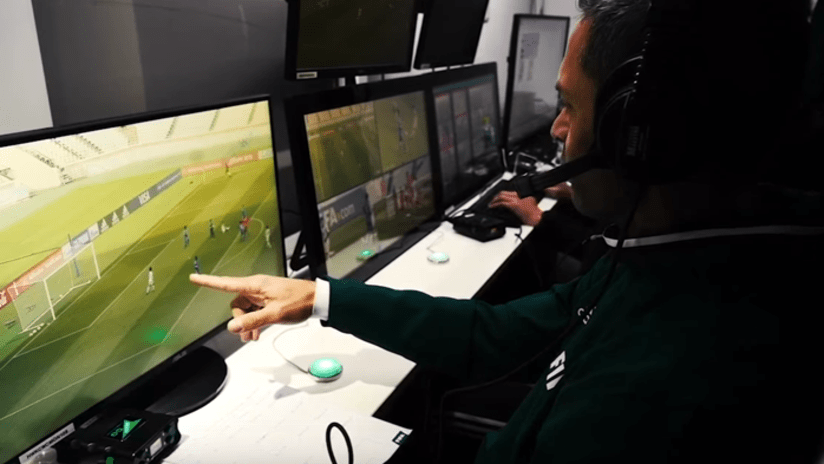Minimum interference, maximum benefit.
That, at its core, is the goal for the Video Assistant Referee (VAR) program, which is being implemented across Major League Soccer starting this Saturday after years of planning. Video review in MLS is “not meant to change the way the game is played,” according to Howard Webb, a retired world-renowned FIFA referee who is heading the VAR program, but rather to ensure “clear mistakes are avoided.”
“We ask the question: not was the referee right but was the referee clearly wrong?” Webb said.
Let’s dive right into it – no pun intended.
There are four match-changing situations that are eligible for review: goals, penalty decisions, direct red cards, and cases of mistaken identity. That includes not only the plays themselves that fall into these categories but also the build-up, known as the “attacking phase of play,” which begins when the team starts the attacking move that leads to the match-changing incident.
So how exactly will the video review process work?
For starters, there will be a certified Professional Referee Organization (PRO) official situated in a booth in the stadium – named the Video Assistant Referee – who will be continuously checking all the plays that fall into the four match-changing situations using the camera angles provided by the broadcast feeds. Most broadcasts will have approximately 8-12 different angles. A video review cannot be requested by coaches or players. There is no coach’s challenge.
This is the responsibility of the VAR.
“It’s not a case of the referees having to speak to the players or coaches to say go and check this one,” said Webb, whose 25-year career saw him officiate more than 500 English Premier League and Football League matches and both the FIFA World Cup and UEFA Champions League finals. “Everything is being checked throughout the game.”
The VAR program was tested over the last several months in various matches in North America and, on average, there were approximately nine “checks” per game.
Most of these checks occur fluidly without public indication or stoppage of play, though there are certain situations where the referee will hold play, signalling his finger to his earpiece, to allow the VAR time to complete the check.
“If there’s a stoppage of play after an incident and play restarts before the incident is checked, the referee can’t go back to it,” Webb said. “The window is closed. That’s why sometimes referees will hold the play.”
If the VAR alerts the referee to a clear and obvious error or serious missed incident in one of the four categories, then the referee will either accept the VAR’s recommendation and change the call or he will review the play himself on a sideline monitor at the first natural stoppage or when the ball is in a neutral zone.
At that point, the referee will make a TV box motion to signal the review. It will also be communicated in stadium and on the broadcast.
“We feel the centre referee in most cases should be the one who makes the final decision,” Webb said. “That’s the way it works in many North American sports. I think there’s credibility in the referee taking a look again at the play and making the final judgment on what has or hasn’t happened.”
“If it’s really clearly factual, for example if the ball was two yards out of play before coming back in and there’s a goal scored straight after or if a player was three yards offside, then we don’t advocate the referee on the field going to the pitchside monitor. We feel that would just add time that’s not necessary. But if there’s any element of interpretation needed, and that happens a lot in soccer, then we want the referee to go there and make the final determination.”
Once a review takes place, the final outcome – and decisive camera angle – will be shown on the videoboard in stadium and on the broadcast.
- READ: A closer look at video review in MLS: Goals and penalty decisions
- READ: A closer look at video review in MLS: Red cards and mistaken identity
Based on the aforementioned VAR tests, there were only 0.36 reviews per match (26 reviews in 90 matches). And in those matches that reviews did occur, the total process – from the check/recommendation to the restart of play – added approximately 1:16.
“It takes a bit of time, of course, but not as much as you might think,” Webb said.
“Video review will not change the basic way the game is played, nor are we aiming for 100 per cent accuracy. Referees make hundreds of decisions every game, and if we checked every single one it would change the way the game is played. But video review will improve the game and give referees the help that they need.”
VIDEO ASSISTANT REFEREE PROCESS
Step 1: VAR checks play in question (goal, PK, direct red card, or mistaken identity)
Step 2: VAR recommends review to centre referee in event of clear and obvious error
Step 3: Referee overturns call based on VAR recommendation OR reviews on sideline monitor
Step 4: Referee makes final decision
Step 5: Final decision communicated in stadium and on broadcast – with decisive angle


